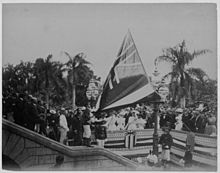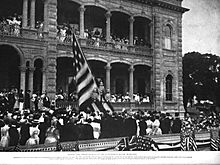Newlands Resolution facts for kids
The Newlands Resolution was a special law passed by the United States Congress on July 7, 1898. This law allowed the U.S. to officially take over, or annex, the independent country of Hawaii. Two years later, in 1900, Congress created the Territory of Hawaii. This meant Hawaii became a part of the United States, but not yet a state.
This resolution was written by a politician named Francis G. Newlands from Nevada. Taking over Hawaii was a very debated topic at the time. It was similar to the discussions about the U.S. taking control of the Philippines in 1898.
Contents
How Hawaii Became Part of the U.S.
In 1897, U.S. President William McKinley tried to make a formal agreement, called a treaty, to annex Hawaii. However, this treaty was never fully approved by the United States.
Hawaii's Role in Wartime
In April 1898, the United States started a war with Spain. The Republic of Hawaii said it would stay neutral, meaning it wouldn't pick a side. But in reality, Hawaii helped the U.S. a lot. It showed how valuable Hawaii was as a naval base during the war. This support made many Americans happy and helped change their minds about Hawaii.
The Vote and Official Transfer
Because the opposition to annexation was weaker, Hawaii was annexed through the Newlands Resolution. This type of agreement only needed a simple majority vote in both parts of Congress. Even though a Democrat wrote the bill, most of the support came from Republicans.
The House of Representatives voted 209 to 91 in favor of the resolution. Most of the "yes" votes came from Republicans. The Senate also passed it with a vote of 42 to 21. This was more than the two-thirds majority needed. President McKinley approved the resolution on July 4, 1898, and signed it on July 7.
On August 12, a special ceremony took place at ʻIolani Palace in Hawaii. This event marked the official transfer of Hawaii's independence to the United States. Some Hawaiian citizens did not agree with this and did not attend the ceremony. They did not believe the event was legal or right.
What Happened Next?
The resolution set up a group of five people to study what laws Hawaii would need. This group included Sanford B. Dole, who became the first governor of the new U.S. Territory of Hawaii. Other members were Senators Shelby M. Cullom and John Tyler Morgan, Representative Robert R. Hitt, and former Hawaii Chief Justice Walter F. Frear.
The group's final report was sent to Congress. Lawmakers debated it for over a year. Some in Congress worried that letting Hawaii elect its own government might lead to a state with a majority of non-white citizens.
Annexation allowed Hawaii and the U.S. mainland to trade goods without extra taxes. This kind of trade had mostly already started in 1875. That's when King David Kalakaua of Hawaii made a trade deal with the U.S. In return, the U.S. Navy was given a long-term lease for Pearl Harbor to use as a naval base.
Ongoing Debate
Making Hawaii a U.S. territory was the last step in a long process where Hawaii slowly lost its independence. This decision divided the people living in Hawaii. Some of the native Polynesian population were against the annexation. It happened without any public vote or referendum.
Even today, there is debate among people who support Hawaiian independence and those who don't. They discuss whether the U.S. legally took over Hawaii according to the U.S. Constitution. The Hawaiian sovereignty movement believes the annexation was illegal. However, the U.S. Supreme Court later seemed to agree that Hawaii's annexation was legal in a case from 1901.
What it Cost and Gained
As part of the annexation, the United States agreed to take on $4 million of Hawaii's debt. A researcher named David R. Barker from the University of Iowa said in 2009 that Hawaii has been good for the U.S. financially. Unlike the Alaska Purchase, Hawaii has generally brought in more tax money than the U.S. spent there (not counting defense costs). He estimated that the U.S. gained more than 15% back on its investment in Hawaii.
See also
 In Spanish: Anexión de Hawái para niños
In Spanish: Anexión de Hawái para niños



